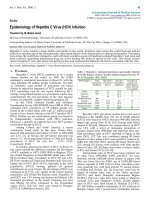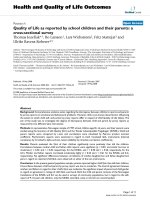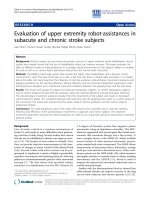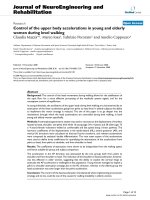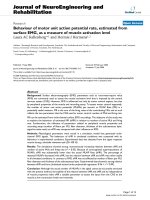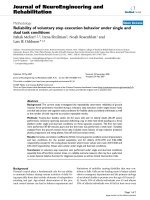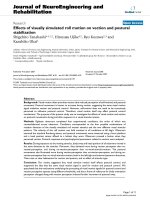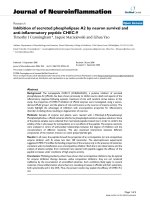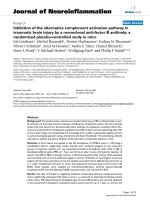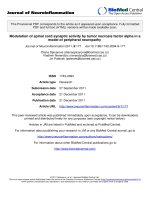Báo cáo hóa học: " Separation of Hepatitis C genotype 4a into IgG-depleted and IgG-enriched fractions reveals a unique quasispecies profile" docx
Bạn đang xem bản rút gọn của tài liệu. Xem và tải ngay bản đầy đủ của tài liệu tại đây (333.45 KB, 9 trang )
BioMed Central
Page 1 of 9
(page number not for citation purposes)
Virology Journal
Open Access
Research
Separation of Hepatitis C genotype 4a into IgG-depleted and
IgG-enriched fractions reveals a unique quasispecies profile
Isabelle Moreau*
1
, Hilary O'Sullivan
1
, Caroline Murray
1
, John Levis
1
,
Orla Crosbie
2
, Elizabeth Kenny-Walsh
2
and Liam J Fanning
1
Address:
1
Molecular Virology Diagnostic & Research Laboratory, Department of Medicine, Clinical Sciences Building, Cork University Hospital,
Cork, Ireland and
2
Department of Gastroenterology, Cork University Hospital, Cork, Ireland
Email: Isabelle Moreau* - ; Hilary O'Sullivan - ; Caroline Murray - ;
John Levis - ; Orla Crosbie - ; Elizabeth Kenny-Walsh - ;
Liam J Fanning -
* Corresponding author
Abstract
Background: Hepatitis C virus (HCV) circulates in an infected individual as a heterogeneous
mixture of closely related viruses called quasispecies. The E1/E2 region of the HCV genome is
hypervariable (HVR1) and is targeted by the humoral immune system. Hepatitis C virions are found
in two forms: antibody associated or antibody free.
The objective of this study was to investigate if separation of Hepatitis C virions into antibody
enriched and antibody depleted fractions segregates quasispecies populations into distinctive
swarms.
Results: A HCV genotype 4a specimen was fractionated into IgG-depleted and IgG-enriched
fractions by use of Albumin/IgG depletion spin column. Clonal analysis of these two fractions was
performed and then compared to an unfractionated sample. Following sequence analysis it was
evident that the antibody depleted fraction was significantly more heterogeneous than the antibody
enriched fraction, revealing a unique quasispecies profile. An in-frame 3 nt insertion was observed
in 26% of clones in the unfractionated population and in 64% of clones in the IgG-depleted fraction.
In addition, an in-frame 3 nt indel event was observed in 10% of clones in the unfractionated
population and in 9% of clones in the IgG-depleted fraction. Neither of these latter events, which
are rare occurrences in genotype 4a, was identified in the IgG-enriched fraction.
Conclusion: In conclusion, the homogeneity of the IgG-enriched species is postulated to
represent a sequence that was strongly recognised by the humoral immune system at the time the
sample was obtained. The heterogeneous nature of the IgG-depleted fraction is discussed in the
context of humoral escape.
Background
Hepatitis C is a virus affecting more than 170 million peo-
ple worldwide and presents a major challenge to the
health care system [1]. The virus can result in chronic hep-
atitis in about 50% to 80% of cases [2-4]. HCV, a member
of the Flaviviridae family, has a linear, single stranded RNA
Published: 23 September 2008
Virology Journal 2008, 5:103 doi:10.1186/1743-422X-5-103
Received: 27 August 2008
Accepted: 23 September 2008
This article is available from: />© 2008 Moreau et al; licensee BioMed Central Ltd.
This is an Open Access article distributed under the terms of the Creative Commons Attribution License ( />),
which permits unrestricted use, distribution, and reproduction in any medium, provided the original work is properly cited.
Virology Journal 2008, 5:103 />Page 2 of 9
(page number not for citation purposes)
genome of approximately 9.6 kilobases in length which
encodes a polyprotein of about 3,100 amino acids [5].
Currently, seven main genotypes have been determined,
which can be further divided into several distinct subtypes
[5]. HCV exists within an infected individual as a dynamic
population of heterogeneous but closely related variants
designed as quasispecies [1,6].
The high level of diversity in HCV is primarily due to the
RNA-dependent RNA polymerase, which lacks a 3'–5'
proofreading function. Hence, the daughter genomes will
be similar but not identical [6,7].
In a quasispecies population advantageous mutations are
recurrently selected for replication where a dynamic proc-
ess of continuous positive selection exists [7]. This evolu-
tion of HCV quasispecies is driven, in part, by the
humoral immune system [7]. The sequence diversity
exhibited during quasispecies evolution has been postu-
lated to be related to HCV persistence and to influence
HCV pathogenesis [8,7].
Although characteristically variable and postulated to be a
flexible structure, the HVR1 has genetic constraints upon
its amino acid composition. Penin et al found that while
the amino acid variability of the HVR1 in response to the
immune pressure is extensive, the conformation and the
physicochemical properties of the HVR1 were ultimately
conserved [9]. The HVR1 is primarily basic, indicative of
the interactions with negatively charged molecules such as
lipids, proteins or glycosaminoglycans [9,10].
Serum samples from patients infected with HCV can be
fractionated by centrifugation. Studies have shown that
the low density fractions, in contrast to high density frac-
tions, are enriched for immunoglobulin (IgG) free HCV
particles and plasma lipoproteins [11]. The low density
fraction may represent a more highly infectious fraction,
compared to the immunoglobulin G (IgG) associated
fraction [12,11]. The binding of antibodies to the HCV
HVR1 has been shown in vitro to prevent the initiation of
the replication cycle in susceptible cells [13]. The bound
antibody likely inhibits the engagement between the vir-
ion and the target receptor [14]; although recent evidence
may suggest that antibody dependent enhancement of
infection is a feature of the HCV life cycle [15]. In contrast
to centrifugation, the use of a solid phase monoclonal
antibody based fractionation methodology lends itself to
greater selective separation of an IgG-enriched Hepatitis C
virion fraction from the IgG-depleted fraction. Centrifuga-
tion based separation, with respect to IgG, can be incom-
plete with fraction cross contamination evident when
separation is measured by RT-PCR.
As the immune system responds to the presence of HCV
epitopes, the specific antibody titre rises and susceptible
virions are culled from the quasispecies. This positive
selection influences the emergence of escape mutants
leading to the emergence of virions with altered surface
glycoprotein [13]. This latter phenomenon implies that
the size and heterogeneity of the fractions obtained after
antibody depletion are likely to vary temporally.
Results
Clonal analysis and sequence data
A total of 38 clones were analysed as follows; 19 unfrac-
tionated clones, 11 IgG-depleted clones and 8 IgG-
enriched clones. All the 38 sequences of 320 bp in length,
encompassing the HVR1, were aligned at both the nucle-
otide and the amino acid level. The 19 unfractionated
clones corresponded to 12 unique clones at the nucle-
otide level [EU482129
–EU482140] and 9 species at the
amino acid level. The 11 IgG-depleted clones corre-
sponded to 8 unique clones at the nucleotide level
[EU482141
–EU482148] and 7 species at the amino acid
level. The 8 IgG-enriched clones corresponded to 1
unique quasispecies at both the nucleotide and the amino
acid level [EU482135
].
Figure 1(A–C) shows the three different alignment pro-
files at the amino acid level, obtained for the unfraction-
ated sample (A), the IgG-depleted fraction (B) and the
IgG-enriched fraction (C). The quasispecies correspond-
ing to accession number EU482135
was the subdominant
quasispecies of the unfractionated sample present in 21%
of clones (n = 4/19) and was recovered in 100% of the
IgG-enriched clones (n = 8/8) (Figure 1C). Hence, a com-
pletely homogeneous population had been recovered for
the IgG-enriched fraction. Furthermore, this quasispecies
[EU482135
] was not identified within the IgG-depleted
fraction (Figure 1B).
26% of the unfractionated clones were identified to have
an in-frame 3 nt insertion (n = 5/19), which corresponded
to an inserted histidine residue at position 3 of the HVR1
[EU482130
, EU482131, EU482132, EU482139,
EU482140
] (Figure 1A). This event also occurred in 64%
of the IgG-depleted fraction (n = 7/11). These 7 IgG-
depleted clones were reduced to 4 unique quasispecies at
the amino acid level due to non-synonymous mutations
[EU482142
, EU482143, EU482144, EU482148] (Figure
1B), but were not identified within the IgG-enriched frac-
tion (Figure 1C).
A simultaneous in-frame 3 nt indel event was also identi-
fied in 10% of the unfractionated fraction (n = 2/19)
[EU482133
, EU482134] (Figure 1A) and 9% of the IgG-
depleted fraction (n = 1/11) [EU482145
] (Figure 1B). This
event correlated to an inserted histidine residue at posi-
Virology Journal 2008, 5:103 />Page 3 of 9
(page number not for citation purposes)
tion 3 of the HVR1 and a deleted threonine residue at
position 6 of the HVR1. This event was not identified
within the homogenous IgG-enriched fraction (Figure
1C).
The relative frequencies of the different quasispecies
within each fraction are represented in figure 2; at both
the nucleotide (A) and the amino acid level (B). The com-
pletely homogeneous population of the IgG-enriched
fraction is clearly demonstrated in both figure 2(A) and
2(B). At the nucleotide level there are no common species
between the unfractionated fraction and the IgG-depleted
fraction (Figure 2A). Non-synonymous mutations
account for the subsequent overlap at the amino acid level
[EU482129
, EU482130, EU482132, EU482133] (Figure
2B). However, no common species between the IgG-
depleted and IgG-enriched species were observed in either
case.
Phylogenetic analysis
A phylogenetic tree was constructed with the unique qua-
sispecies of the unfractionated, the IgG-depleted and the
IgG-enriched fractions at the amino acid level (figure 3).
The inter-relatedness between the different quasispecies is
clearly visible. The tree was rooted with the single unique
quasispecies of the IgG-enriched population [EU482135
],
as this species was postulated to be the ancestral species
from which the IgG-depleted quasispecies evolved.
Discussion
Hepatitis C exists as a diverse population of quasispecies.
The heterogeneity of the HCV genome is distributed une-
Amino acid alignment of the individual species obtained from each fractionFigure 1
Amino acid alignment of the individual species obtained from each fraction. (A) unfractionated serum, (B) IgG-
depleted fraction and (C) IgG-enriched fraction. The black box encloses the 27 amino acid sequence of the HVR1. The asterisk
(*) indicate the position of the histidine insertion which is shown in bold (H). The (Δ) indicate the position of the deletion event
when present. The closed circles indicate consensus sequence across all species.
1 60
EU482129 AWDMMMNWSPTTTLLLAQVMRIPGTLVDLLAGGHWGVLVGVAYFSMQANWAKVILVLFLF
EU482135
EU482138 C
EU482136
EU482137
EU482139* T
EU482130* T
EU482131* T
EU482132*
EU482140* T
EU482133** S T
EU482134** S T
61 * Δ 108
EU482129 AGVDA GT ITTGSVAARGVSRVTGFLTPGPKQN LQLINTNGSWHINRT
EU482135 G
EU482138
EU482136 K- T A FA S
EU482137 K- T A FA S
EU482139* RAHT
EU482130* RAHT A AKHIA-LFDS-SR
EU482131* RAHT A AKHIA-LFDS-SR
EU482132* HT A ANH-A-LFSF-SR
EU482140* HT A A-HLA-LFST-SR
EU482133** E-H Δ-A—-SSNAQKF-SLF-F Q
EU482134** E-H Δ-A SSNAQKF-SLF-F Q
. . . .
1 60
EU482142* AWDMMMNWSPTTTLLLAQVMRIPGTLVDLLTGGHWGVLVGVAYFSMQANWAKVILVLFLF
EU482143*
EU482144* A
EU482148*
EU482145** S
EU482141 A
EU482146
EU482147 A
61 * Δ 108
EU482142* AGVDA RAHTTTGAVAARGAKHIAGLFDSGSRQN LQLINTNGSWHINRT
EU482143*
EU482144* GT N-V SF
EU482148* GT N-V SF
EU482145** ET-I-Δ SSN-QKFTS TF-PQ
EU482141 GT I S VSRVT-FLTP-PK
EU482146 GT I S V-RVT-FLTP-PK
EU482147 GT I S V-RVT-FLTP-PK
. . .
1 60
EU482135/Clone1 AWDMMMNWSPTTTLLLAQVMRIPGTLVDLLAGGHWGVLVGVAYFSMQANWAKVILVLFLF
Clone2
Clone3
Clone4
Clone5
Clone6
Clone7
Clone8
61 107
EU482135/Clone1 AGVDA GTITTGSVAARGVGRVTGFLTPGPKQN LQLINTNGSWHINRT
Clone2
Clone3
Clone4
Clone5
Clone6
Clone7
Clone8
HVR1
HVR1 HVR1
A
BC
Virology Journal 2008, 5:103 />Page 4 of 9
(page number not for citation purposes)
Figure 2 (see legend on next page)
Quasispecies Complexity at Nucleotide Level Within E1/E2 Region
0
10
20
30
40
50
60
70
80
90
100
Unfractionated IgG Depleted IgG Enriched
Identical Clones (%)
EU482148*
EU482140*
EU482139*
EU482138
EU482147
EU482146
EU482137
EU482136
EU482135
EU482134**
EU482145**
EU482133**
EU482144*
EU482132*
EU482143*
EU482131*
EU482142*
EU482130*
EU482141
EU482129
Quasispecies Complexity at Amino Acid Level Within E1/E2 Region
0
10
20
30
40
50
60
70
80
90
100
Unfractionated IgG Depleted IgG Enriched
Identical Clones (%)
EU482148*
EU482140*
EU482139*
EU482138
EU482147
EU482146
EU482136
EU482135
EU482133**
EU482132*
EU482130*
EU482129
A
B
Virology Journal 2008, 5:103 />Page 5 of 9
(page number not for citation purposes)
qually across the viral genome. Significant genomic varia-
tion occurs within the HVR1 [16]. The purpose of this
investigation was to determine if IgG depletion would
alter the quasispecies profile as assessed by the sequence
diversity within the HVR1 region. The Qiagen Albumin/
IgG Depletion Spin Column provided a quick, convenient
alternative to centrifugation for the separation of HCV
particles into IgG-depleted and IgG-enriched fractions.
Sequence comparison between the IgG-enriched and
depleted fractions allows an insight into possible reasons
why the IgG-depleted quasispecies were not associated
with immunoglobulin molecules (Figure 1). A glycine res-
idue at amino acid position 14 of the 27 amino acids of
the HVR1 of the IgG-enriched quasispecies population
was not evident in any of the quasispecies from the IgG-
depleted fraction (Figure 1B and 1C). It is possible that a
glycine at this position was important for immune recog-
nition and that mutation enabled effective humoral
immune escape. Strikingly, the replacement residue at
position 14 in the depleted fraction was a polar, yet
hydrophilic amino acid; lysine (K), serine (S), asparagine
(N) or glutamine (Q) (Figure 1).
The observed in-frame 3 nt insertion event appears to be
the first documentation of this phenomenon in Hepatitis
C genotype 4a, as no sequence similarities were found
when comparing these sequences against GenBank data-
base. The significance of the inserted histidine, which was
identified in the unfractionated and the IgG-depleted frac-
tion, may lie in the ability of these diverse hypervariable
regions to escape recognition by the humoral and perhaps
cytotoxic arms of the immune system through disruption
of dominant epitopes, although this requires further
investigation.
A simultaneous in-frame 3 nt indel event was also
observed in the unfractionated and IgG-depleted popula-
tion at amino acid positions 3 and 6 of the HVR1
[EU482133
and EU482145], figure 1(A) and 1(B) respec-
tively. This scenario has rarely been reported in the Hepa-
titis C genome [17] and, to our knowledge, never in
genotype 4a isolate. The mechanism for this in-frame
deletion is difficult to rationalise as there is no known
ligase function associated with the RNA dependent RNA
polymerase encoded by the NS5B gene of the virus. The
presence of naturally occurring recombinants in vivo, such
as 2k/1b, 2i/6p and 2k/5a, may indicate the potential for
the RNA dependent RNA polymerase genome to "jump"
during either positive or negative strand replication [18-
20]. Intra strand switching may account to the 3 nt in-
frame indel events observed here [EU482133
, EU482134
and EU482145] (Figure 1A–B).
There is significant evolutionary pressure for the HVR1
region to maintain a constant length of 27 amino acids
[21]. The simultaneous indel event could be accredited to
this evolutionary pressure. These quasispecies
[EU482133
, EU482134 and EU482145] maintain a 27
amino acid length HVR1 (Figure 1A–B). However, the
mutations are functionally distinct from those present in
the consensus sequence of the IgG-enriched fraction.
Interestingly, the deleted residue, threonine (T), is a con-
served polar residue in all of the other unfractionated,
IgG-enriched and IgG-depleted species [EU482129
–
EU482132
, EU482135–EU482144 and EU482146–
EU482148
] (Figure 1). This specific deletion may have
disrupted the consensus sequence of the epitope towards
which the circulating neutralising antibodies may be
directed. Castro et al recently reported the existence of
indels in the HIV genome and suggested that a triplet
repeat expansion mutational mechanism may be respon-
sible [22]. However, the HCV HVR1 within which these
indels were identified does not contain any overt repeated
motifs. Mechanistically the replicases of lentiviruses and
flaviviruses, which have different templates, may have
unique biofunctional activities that endow the quasispe-
cies with niche isolates which can evade immune detec-
tion that concomitantly maintain viral persistence and/or
impact on pathogenicity.
It has been demonstrated that antibodies raised against
the C-terminus of the HVR1 may be broadly cross-reactive
and have a high capacity to capture HCV variants, indicat-
ing a conserved, partially conformational epitope [23].
The physicochemical limitations in the evolution of the
Quasispecies complexity within E1/E2 region in the unfractionated serum, the IgG-depleted fraction and the IgG-enriched frac-tion: (A) at the nucleotide level and (B) at the amino acid levelFigure 2 (see previous page)
Quasispecies complexity within E1/E2 region in the unfractionated serum, the IgG-depleted fraction and the
IgG-enriched fraction:(A) at the nucleotide level and (B) at the amino acid level. The vertical bars indicate the proportion of
viral variants within each sample. Within the vertical bars, each variant is represented by a different colour. The same colour
indicates identity between viral strains present in different fractions. The accession numbers and corresponding viral variant
colour code of each strain are shown in the legend box where font colour corresponds to each fraction as follows: red for the
unfractionated serum, blue for the IgG-depleted fraction, green for the IgG-enriched fraction [EU482135
] was also the sub-
dominant species of the unfractionated fraction), and black for quasispecies present in both unfractionated and IgG-depleted
fractions. An accession number followed by an asterisk (*) indicates the presence of an insertion event within the sequence or
2 asterisks (**) indicates the presence of an indel event.
Virology Journal 2008, 5:103 />Page 6 of 9
(page number not for citation purposes)
Phylogenetic trees of all viral E1/E2 amino acid sequences encompassing the HVR1 within each fractionFigure 3
Phylogenetic trees of all viral E1/E2 amino acid sequences encompassing the HVR1 within each fraction. The
phylogenetic tree was constructed with the Treecon software and rooted with the unique IgG-enriched species [EU482135
].
The genetic distance is shown as a scale bar. A bootstrap analysis using 100 bootstrap replicates was performed to assess the
reliability of each branch point. Bootstrap scores are given as percentage value. The values greater than 70% are annotated at
appropriate branches. Different font colours are used to represent the different fractions: red for the unfractionated serum
species, blue for the IgG-depleted species and green for the IgG-enriched species, [EU482135
] was also the subdominant spe-
cies of the unfractionated fraction. The species with the insertion event are represented in the figure by an asterisk (*) and the
species with the indel event are represented by 2 asterisks (**).
Virology Journal 2008, 5:103 />Page 7 of 9
(page number not for citation purposes)
HRV1 may constrain the exact nature of these insertion
and indel events in the N-terminus region, thereby
restricting the possibility of other dominant epitopes
occurring, resulting in the persistence of a particular
genetic signature within a diverse population of virions.
This will require further prospective evaluation, perhaps
by ultra-deep pyrosequencing [24].
Phylogenetic analysis suggests that the homogeneous IgG-
enriched quasispecies [EU482135
], was the ancestral spe-
cies from which the variants present in the IgG-depleted
fraction evolved (Figure 3). Sequence alignments indicate
that the conserved residues of the IgG-depleted species
within HVR1 are [ T-G-VA G QN] (Figure 1B).
Interestingly, the conserved amino acid residues of the
IgG-depleted fraction within HVR1 are identical to the
amino acids residues of the putative ancestral species
[EU482135
] at the corresponding positions (Figure 1C).
This is indicative of the evolutionary constraints on the
sequence of the HVR1 as previously shown by Lin et al.
[25]. Furthermore, the IgG-depleted quasispecies har-
bouring the indel events are the furthest evolved species
from the IgG-enriched quasispecies (genetic distance of
0.180, according to the scale bar in Figure 3), whereas the
quasispecies harbouring the deletion events within the
IgG-depleted population represent an intermediate evolu-
tion state (genetic distance ranging from 0.153 to 0.041,
according to the scale bar in Figure 3). These variants are
possible progenitors of the next swarm of escape mutants.
Conclusion
Separation of a complex mixture of antibody enriched
and antibody depleted HCV particles is technically not
trivial. Centrifugation based separation, with respect to
IgG, can be incomplete with fraction cross contamination
evident when separation is measured by RT-PCR. The use
of a solid phase monoclonal IgG depletion strategy pro-
vides a fast and relatively simple method for separation of
HCV viral particles from a serum sample. We have dem-
onstrated that an IgG-depleted fraction can be molecu-
larly more diverse than the quasispecies profile of the IgG-
enriched fraction. The IgG-depleted fraction was popu-
lated with genomes with an insertion and indel events.
This is the first documentation of such occurrences in
Hepatitis C genotype 4a. These quasispecies are likely to
represent humoral escape mutants and suggest that sepa-
rations based on viral-antibody complexes will likely
exhibit temporal patterns of change.
Methods
Serum sample
A serum sample from a panel of viraemic sera positive for
HCV genotype 4a was randomly selected. The VERSANT
®
HCV Genotype Assay (LiPA) was used to confirm the gen-
otype of this HCV sample [26]. The viral load measure-
ment was previously determined by use of Ampliprep/
COBAS-TaqMan 48 platform (Roche Diagnostics, UK)
and was found to be 6.37 log
10
IU/ml. A waiver of consent
was provided by Clinical Research Ethics Committee of
the Cork Teaching Hospitals as the sample used in this
study was surplus to requirements following diagnostic
investigations.
Serum sample fractionation into IgG-depleted and IgG-
enriched fractions
The original serum sample was separated into IgG-
enriched and IgG-depleted fractions using Albumin/IgG
Depletion Spin Columns following the Qproteome Albu-
min/IgG Depletion protocol (Catalogue No: 37521, QIA-
GEN, UK). This column exploits the use of monoclonal
antibodies which can bind human serum albumin and
human IgG with high affinity and specificity.
As per manufacturers protocol, 25 μl of serum was diluted
in 75 μl of dilution buffer (Phosphate Buffered Saline,
PBS). The diluted serum sample was applied to the col-
umn. The flow-through was collected through centrifuga-
tion and contained the IgG-depleted fraction. The column
was then washed twice with PBS, collecting eluate by cen-
trifugation. These eluates were combined in order to
increase the amount of IgG-depleted viral particles recov-
ered. Two additional wash steps were performed with PBS
in order to limit contamination of the IgG-enriched frac-
tion with any IgG-free viral particles. These eluted vol-
umes were discarded.
250 μl of Lysis/Binding Buffer of the MagNA Pure LC Total
Nucleic Acid Isolation Kit (Roche Diagnostics, UK) was
then added directly to the column to lyse the IgG-enriched
viral particles. The column was then inverted and mixed
on the end-over-end shaker (DYNAL sample mixer) for 5
minutes at room temperature followed by centrifugation.
Another 250 μl of Lysis/Binding Buffer (Roche Diagnos-
tics, UK) was then added and the mixing step and centrif-
ugation was repeated. These two fractions were then
combined.
HCV RNA extraction
HCV RNA was extracted on the MagNA Pure LC (Roche
Diagnostics Ltd. UK,) according to the MagNA Pure LC
Total Nucleic Acid Isolation Kit protocol (Catalogue No:
03038505001, Roche Diagnostics Ltd., UK) from 25 μl of
an unfractionated serum sample, in addition to the IgG-
depleted eluate and the lysed material of the IgG-enriched
fraction.
Amplification of E1/E2 region encompassing the HVR1
Reverse Transcription was performed as previously
described by [27].
Virology Journal 2008, 5:103 />Page 8 of 9
(page number not for citation purposes)
Amplification of the E1/E2 region encompassing the
HVR1 was performed using nested primers and hence, Set
I previously described by Lin et al, resulting in a 320 bp
fragment extending from nucleotides 1234–1553 accord-
ing to isolate ED43 reference strain genotype 4a (Gen-
Bank accession no Y11604
). The primer sequences used
were as follows (5' to 3'): outer forward, OF (I),
ATGGCATGGGATATGAT; outer reverse, OR (I), AAG-
GCCGTCCTGTTGA; inner forward, IF (I), GCATGGGA-
TATGATGATGAA; inner reverse, IR (I),
GTCCTGTTGATGTGCCA. The PCR reactions were per-
formed with the proofreading Pwo DNA polymerase
(Roche Molecular Biochemicals, UK) as previously
described by [27]. All E1/E2 amplicons were gel purified
and cloned into Zero Blunt
®
TOPO
®
PCR Cloning Kit (Cat-
alogue No: K2895-40, Invitrogen, Belgium). Plasmid
DNA purification was performed using the QIAprep Min-
iprep Kit (Catalogue No: 27104, Qiagen, UK) before
sequencing.
Sequence analysis of the E1/E2 region
Positive clones were sequenced by MWG-Biotech http://
www.eurofinsdna.com/home.html Germany. E1/E2 320
bp sequences were aligned using ClustalW2 http://
www.ebi.ac.uk/Tools/clustalw2/, MultAlin http://bio
info.genopole-toulouse.prd.fr/multalin/multalin.html
and analysed using the NCBI BLAST N (nucleotide) web
program />.
Phylogenetic analysis
A phlyogenetic tree was constructed by use of TREECON
software />details/3. The cut-off bootstrap value was 70% with 100
replicates.
Accession numbers
The sequences reported in this study have been assigned
the following GenBank accession numbers: unfraction-
ated [EU482129
–EU482140] and IgG-depleted
[EU482141
–EU482148]. The single unique species iden-
tified for the IgG-enriched fraction had been identified
within the unfractionated population [EU482135
].
Competing interests
The authors declare that they have no competing interests.
Authors' contributions
IM supervised the experiments and contributed to data
analysis and preparation of manuscript. HO'S performed
all the experiments and contributed to data analysis and
preparation of manuscript. CM contributed to the experi-
ments and data analysis. JL determined qualitative, quan-
titative and genotype of clinical specimens described here.
OC and EKW are clinicians who manage HCV at Cork
University Hospital. LJF supervised the project and
assisted with preparation of manuscript. All authors have
read and approved the present manuscript.
Acknowledgements
This study was supported in part by the Health Research Board grant 505-
005-711-4912.
References
1. Bowen DG, Walker CM: The origin of quasispecies: cause or
consequence of chronic hepatitis C viral infection? J Hepatol
2005, 42:408-417.
2. Kenny-Walsh E: Clinical outcomes after hepatitis C infection
from contaminated anti-D immune globulin. Irish Hepatol-
ogy Research Group. N Engl J Med 1999, 340:1228-1233.
3. Chevaliez S, Pawlotsky JM: Hepatitis C virus: virology, diagnosis
and management of antiviral therapy. World J Gastroenterol
2007, 13:2461-2466.
4. Brass V, Moradpour D, Blum HE: Molecular virology of hepatitis
C virus (HCV): 2006 update. Int J Med Sci 2006, 3:29-34.
5. Suzuki T, Ishii K, Aizaki H, Wakita T: Hepatitis C viral life cycle.
Adv Drug Deliv Rev 2007, 59:1200-1212.
6. Le Guillou-Guillemette H, Vallet S, Gaudy-Graffin C, Payan C, Pivert
A, Goudeau A, Lunel-Fabiani F: Genetic diversity of the hepatitis
C virus: impact and issues in the antiviral therapy. World J Gas-
troenterol 2007, 13:2416-2426.
7. Timm J, Roggendorf M: Sequence diversity of hepatitis C virus:
implications for immune control and therapy. World J Gastro-
enterol 2007, 13:4808-4817.
8. Ray SC, Wang YM, Laeyendecker O, Ticehurst JR, Villano SA, Thomas
DL: Acute hepatitis C virus structural gene sequences as pre-
dictors of persistent viremia: hypervariable region 1 as a
decoy. J Virol 1999, 73:2938-2946.
9. Penin F, Combet C, Germanidis G, Frainais PO, Deleage G, Pawlotsky
JM: Conservation of the conformation and positive charges of
hepatitis C virus E2 envelope glycoprotein hypervariable
region 1 points to a role in cell attachment. J Virol 2001,
75:5703-5710.
10. Dubuisson J, Helle F, Cocquerel L: Early steps of the hepatitis C
virus life cycle. Cell Microbiol 2008, 10:821-827.
11. Bartosch B, Verney G, Dreux M, Donot P, Morice Y, Penin F, Pawlot-
sky JM, Lavillette D, Cosset FL: An interplay between hypervari-
able region 1 of the hepatitis C virus E2 glycoprotein, the
scavenger receptor BI, and high-density lipoprotein pro-
motes both enhancement of infection and protection against
neutralizing antibodies. J Virol 2005, 79:8217-8229.
12. Andre P, Komurian-Pradel F, Deforges S, Perret M, Berland JL, Sod-
oyer M, Pol S, Brechot C, Paranhos-Baccala G, Lotteau V: Charac-
terization of low- and very-low-density hepatitis C virus
RNA-containing particles. J Virol 2002, 76:6919-6928.
13. Hino K, Fujii K, Korenaga M, Murakami C, Okazaki M, Okuda M,
Okita K: Correlation between relative number of circulating
low-density hepatitis C virus particles and disease activity in
patients with chronic hepatitis C. Dig Dis Sci 1997,
42:2476-2481.
14. Shimizu YK, Hijikata M, Iwamoto A, Alter HJ, Purcell RH, Yoshikura
H: Neutralizing antibodies against hepatitis C virus and the
emergence of neutralization escape mutant viruses. J Virol
1994, 68:1494-1500.
15. Meyer K, Ait-Goughoulte M, Keck ZY, Foung S, Ray R: Antibody-
dependent enhancement of hepatitis C virus infection. J Virol
2008, 82:2140-2149.
16. Polyak SJ, Sullivan DG, Austin MA, Dai JY, Shuhart MC, Lindsay KL,
Bonkovsky HL, Di Bisceglie AM, Lee WM, Morishima C, Gretch DR:
Comparison of amplification enzymes for Hepatitis C Virus
quasispecies analysis. Virol J 2005, 2:41.
17. Gerotto M, Dal Pero F, Loffreda S, Bianchi FB, Alberti A, Lenzi M: A
385 insertion in the hypervariable region 1 of hepatitis C
virus E2 envelope protein is found in some patients with
mixed cryoglobulinemia type 2. Blood 2001, 98:2657-2663.
18. Kalinina O, Norder H, Mukomolov S, Magnius LO: A natural
intergenotypic recombinant of hepatitis C virus identified in
St. Petersburg. J Virol 2002, 76:4034-4043.
19. Noppornpanth S, Lien TX, Poovorawan Y, Smits SL, Osterhaus AD,
Haagmans BL: Identification of a naturally occurring recom-
Publish with BioMed Central and every
scientist can read your work free of charge
"BioMed Central will be the most significant development for
disseminating the results of biomedical research in our lifetime."
Sir Paul Nurse, Cancer Research UK
Your research papers will be:
available free of charge to the entire biomedical community
peer reviewed and published immediately upon acceptance
cited in PubMed and archived on PubMed Central
yours — you keep the copyright
Submit your manuscript here:
/>BioMedcentral
Virology Journal 2008, 5:103 />Page 9 of 9
(page number not for citation purposes)
binant genotype 2/6 hepatitis C virus. J Virol 2006,
80:7569-7577.
20. Legrand-Abravanel F, Claudinon J, Nicot F, Dubois M, Chapuy-Regaud
S, Sandres-Saune K, Pasquier C, Izopet J: New natural intergeno-
typic (2/5) recombinant of hepatitis C virus. J Virol 2007,
81:4357-4362.
21. Smith DB: Evolution of the hypervariable region of hepatitis C
virus. J Viral Hepat 1999, 6(Suppl 1):41-46.
22. Castro E, Belair M, Rizzardi GP, Bart PA, Pantaleo G, Graziosi C:
Independent evolution of hypervariable regions of HIV-1
gp120: V4 as a swarm of N-Linked glycosylation variants.
AIDS Res Hum Retroviruses 2008, 24:106-113.
23. Li C, Candotti D, Allain JP: Production and characterization of
monoclonal antibodies specific for a conserved epitope
within hepatitis C virus hypervariable region 1. J Virol 2001,
75:12412-12420.
24. Eriksson N, Pachter L, Mitsuya Y, Rhee SY, Wang C, Gharizadeh B,
Ronaghi M, Shafer RW, Beerenwinkel N: Viral population estima-
tion using pyrosequencing. PLoS Comput Biol 2008, 4:e1000074.
25. Lin HJ, Seeff LB, Barbosa L, Hollinger FB: Occurrence of identical
hypervariable region 1 sequences of hepatitis C virus in
transfusion recipients and their respective blood donors:
divergence over time. Hepatology 2001, 34:424-429.
26. Nadarajah R, Khan GY, Miller SA, Brooks GF: Evaluation of a new-
generation line-probe assay that detects 5' untranslated and
core regions to genotype and subtype hepatitis C virus. Am J
Clin Pathol 2007, 128:300-304.
27. Moreau I, Levis J, Crosbie O, Kenny-Walsh E, Fanning LJ: Correla-
tion between pre-treatment quasispecies complexity and
treatment outcome in chronic HCV genotype 3a. Virol J 2008,
5:78.
